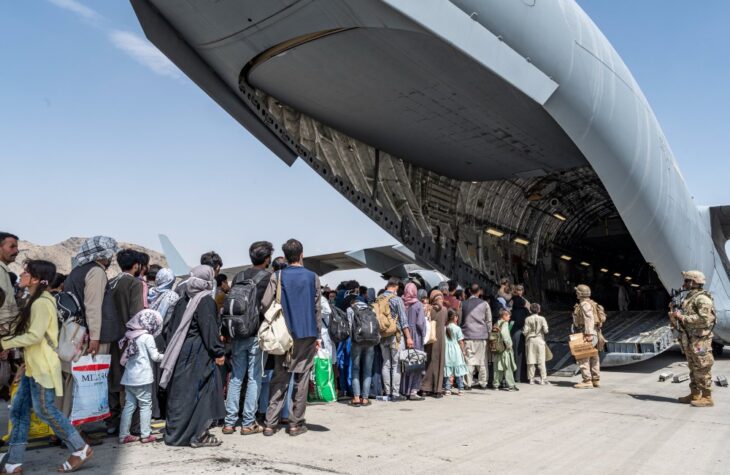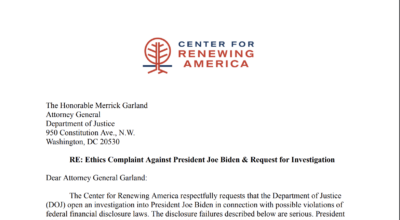
Primer: Refugee Programs Pose Risk to Americans as Afghanistan Collapses
Summary
As the Biden administration’s catastrophe in Afghanistan continues to unfold, the potential resettlement of Afghan refugees will be a prominent policy debate going forward. While Afghans will likely enter the United States through existing programs, the mass importation of potentially hundreds of thousands of people who do not share American cultural, political, or ideological commonalities poses serious risks to both national security and broader social cohesion.
Elected officials and policymakers should prioritize policies that benefit both Americans and the Afghans fleeing the return of the Taliban.
Understanding Existing Refugee Programs
The two primary programs that the U.S. government will likely use to resettle Afghans are the U.S. Refugee Admissions Program (RAP) and the Special Immigrant Visa program (SIV). The RAP was implemented during the Cold War, while the SIV program was created following the U.S. invasion of Afghanistan in the wake of the 9/11 attacks. Both the RAP and SIV programs have caps on the number of individuals or households that can come to the United States, though the details vary and matter a great deal.
The Refugee Admissions Program was created in 1980 and Congress tied it to the Immigration and Nationality Act (INA). This program includes statutory language defining a refugee as one who has a well-founded fear of persecution on account of one’s race, religion, political views, ethnicity, or membership in a particular social group.
Section 207 of the INA allows individuals outside the United States who meet this criteria to be considered for refugee status. The number of refugees who can enter the U.S. on an annual basis fluctuates as that number is decided by the president. Since its inception in 1980, the annual cap has been as high as 231,700 in 1980 and as low as 18,000 in 2020. In total, the program has resettled more than 3 million refugees into American communities.
On May 3, 2021, President Biden increased the cap to 62,500 admissions and has promised to raise it again in 2022 to 125,000 admissions. It should be noted that, to the extent these slots are utilized for those coming from insecure countries, such as Afghanistan and Syria, the security vetting needed to bring them in safely and with confidence is very challenging to accomplish.
Given the oppressive and despotic nature of the Taliban, fleeing Afghans would almost certainly qualify under the statutory definition of refugee in the U.S. code. However, simply because individuals may qualify under current law does not mean it is wise policy to initiate a mass importation of Afghans into the United States.
The Special Immigrant Visa Program was created in 2006, and significantly expanded in 2009, to provide Afghans who worked for the US government, served as translators, or fought with the U.S. military with a special visa for entry into the United States.
The number of available visas has fluctuated over the years as Congress has added new caps in various National Defense Authorization bills as well as in the 2009 omnibus bill. For FY 2021, the total number of SIVs rose to 26,500. However, the number increased once again on July 30, 2021, as part of the Emergency Security Supplemental Appropriations Act and now stands at 34,500 total visas.
However, on August 25, 2021, White House Press Secretary Jen Psaki stated that the Biden administration “has never put a cap” on the number of SIV applicants it plans to evacuate out of Afghanistan. Given these comments, it remains to be seen whether the administration will even abide by the existing statutory cap of the SIV program.
The State Department administers the SIV program, which technically ends when all special visas have been issued. To date, over 15,000 SIVs have already been issued (approximately 750 for each year we have been in Afghanistan), leaving roughly 18,000 remaining visas. Though, unlike the RAP, the SIV program does not include a principal’s spouse and children toward the numerical limit. Therefore, in practice, the SIV program applies to 34,500 Afghan households.
Implications of Mass Afghan Resettlement
Americans may understandably want to protect the Afghans who helped the United States against the Taliban and Al-Qaeda. But while seeking to help those who helped America, we must prioritize our own national security when making policy decisions of this magnitude. The fact remains that the importation and resettlement of tens of thousands of Afghans whom federal officials cannot properly vet may very well pose a security threat to our communities and could further fray social cohesion.
The vetting processes for both the RAP and SIV programs are flawed and do not properly screen for ideological flags. Furthermore, the vetting processes do not provide a robust assessment of individuals in a manner that would determine whether or not they would assimilate well into American society once they arrive. They do not screen for a thorough understanding of American civics, common law, or capitalism and do not assess individuals based on their support for foundational American values like religious liberty and freedom of speech.
The processes are designed to ensure no violent criminals, fugitives, or potentially dangerous individuals are made eligible for U.S. entry through the refugee application protocols. These are important and necessary safeguards, but they are hardly sufficient in our current climate.
Key Implication: National Security Threats
From a national security perspective, the Taliban’s rapid takeover of Afghanistan following 20 years of U.S. military presence leaves a number of dangers that policymakers must take into account, necessitating a full reevaluation of the SIV program.
- Thousands of ISIS, Al-Qaeda, and jihadist fighters still remain in Afghanistan with many hardcore terrorists freed by the Taliban from prisons in the past two weeks.
- The mad rush of Afghans to get on planes leaving Kabul is creating a fluid, chaotic situation on the ground in which vetting processes are simply not up to the standard to ensure that no already-radicalized individuals are boarding planes bound for the United States.
- There are no assurances that some of those being brought to the United States will not harbor resentment toward Americans that manifests into violent action.
All of these realities and factors result in a significant national security threat to American citizens that stems from the rushed importation of thousands of Afghans.
Key Implication: Crime and Lack of Assimilation
Previous analyses of the U.S. border have suggested that the mass immigration of non-citizens into American communities is serving as a catalyst for crime and social discord. There is no reason to believe that potentially hundreds of thousands of Afghans, many of whom are in distress and cannot be properly vetted, will assimilate easily or at all into American society.
For example, a large-scale poll conducted by Pew in 2013 found 99 percent of Afghan Muslims support Sharia law, 78 percent believe Sharia courts should operate in parallel to the existing legal system, and 39 percent believe suicide bombing is often or sometimes justified.
Refugees resettled in the United States from Somalia have included many people who would later go on to radicalize and fight alongside jihadists in Al-Shabaab, Al-Qaeda, ISIS, and other radical terrorist organizations. These individuals were given a home in the United States and later went on to fight with radical groups explicitly attempting to kill Americans.
There are myriad examples of the chaos European nations have faced after accepting thousands of refugees who hold no affinity for their host countries and who failed to assimilate, to the detriment of the citizenry. The ISIS attack in Istanbul in 2016 that killed 10 Germans was carried out by a Syrian refugee who was not properly vetted by the Turkish authorities. In France, multiple suicide bombers who participated in the horrific November 2015 wave of terror attacks, were ISIS jihadists who entered as refugees. According to a study out of Zurich University, young male refugees and migrants were responsible for over 90 percent of the 10 percent increase in crime in Germany from 2014 to 2016. In Sweden, crime from refugee populations has been so profound that entire neighborhoods and cities, like Malmo, have been swarmed with young teen refugees and migrants carrying AK-47s and wearing bulletproof vests in the streets. Referred to as “areas of social exclusion,” these refugee and immigrant-dominated neighborhoods have become a flashpoint in the nation’s struggle with rising crime and violence, including a 10 percent increase in rapes from 2016 to 2017. This is but a sampling of the detrimental effects refugee resettlement policies have had in Europe.
In theory, if officials fully apply both the RAP and SIV programs to Afghans, the U.S. could see nearly 200,000 Afghans brought to the United States this year alone with well over 100,000 more following in 2022. Should existing chain migration provisions be applied to this population, the numbers will swell even more in the years that follow, with a limited ability to screen those who come.
Americans are already experiencing a fraying social fabric because of radical domestic policies like Critical Race Theory, a broken southern border that continues to strain local resources by flooding communities with COVID-19, crime, and drugs, and an alliance between Big Tech and big government to silence speech and ideas that do not comport with the progressive agenda. Relocating hundreds of thousands of people who will not easily, or may never, assimilate into American society will only accelerate community fragmentation and potentially imperil American citizens in their own neighborhoods.
A Better Approach: Regional Resettlement
The better choice for the American people and the Afghans whose lives are endangered by the Taliban is coordination with neighboring nations and American allies that focuses on regional resettlement. Regional resettlement has been the long-standing consensus approach to refugee matters in the entire international community – it is the general rule in circumstances such as Afghanistan now faces, not the exception.
Regional resettlement will ensure that fleeing Afghans maintain better cultural cohesion, share religious values, possess better linguistic and social commonalities, and give Afghans a better chance to integrate and assimilate into their new homes.
With regard to Afghan refugees, there are key policies that must become paramount:
- The Biden administration should negotiate resettlement agreements with neighboring nations like Turkmenistan, Uzbekistan, and Tajikistan. Additionally, pressure should be put on Pakistan, who has long had a cozy relationship with the Taliban, to ensure that the Taliban regime and its jihadist allies do not interfere in regional resettlement.
- The Biden administration should halt any efforts to raise the cap in the Refugee Admissions Program and instead should set lower levels of admissions on an annual basis.
- Congress should immediately examine existing laws that apply to refugees and refugee programs and add measures to our screening processes to assess fully whether an individual would assimilate well into the United States. Every facet of immigration law, be it legal immigration, visa applications, or refugee screening, must be focused on the foundational premise of assimilation.
Conclusion
Given the increasingly dire situation on the ground in Afghanistan and the botched withdrawal of U.S. forces, the best way to help Afghans while protecting American citizens at home is to focus on regional resettlement for Afghan refugees fleeing the Taliban.
The mass importation of potentially hundreds of thousands of people whom we cannot properly vet and who hold few cultural commonalities with us will only further inflame social fragmentation in American communities. A combination of wide open borders and far too lenient visa and refugee programs leaves Americans vulnerable and our national security imperiled.
Our elected officials must be sober-minded and clear-eyed in the days, weeks, and months ahead. Their oath and obligation is first and foremost to the safety and security of the citizens they were elected to represent.




